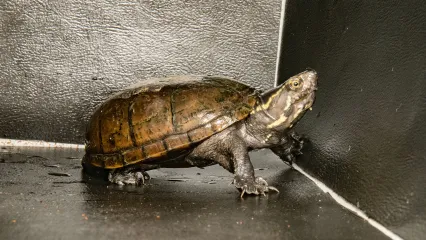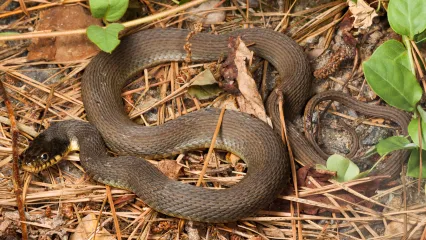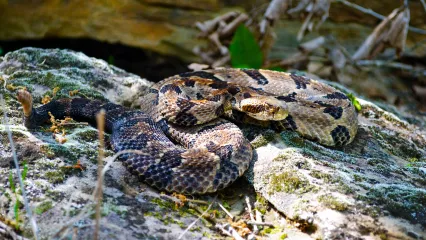
Description
The western chicken turtle is a medium-sized aquatic turtle. The top shell is dark with a faint yellow or orange netlike pattern and a yellow border on the edge of the shell. On the flip side, its bottom shell is yellow with darker marks along the seams of individual scutes. The head and neck have yellow stripes and may be almost as long as the top shell. The legs also have yellow stripes and may resemble striped pants.
There has been a debate of whether the chicken turtle got its name from the exceptionally long neck and egg-shaped shell or because of the taste of its meat.
Size
Adult western chicken turtles are about 4-10 inches in shell length. Females tend to be larger than males. Hatchlings are around an inch in length.
Habitat
The western chicken turtle is one of three chicken turtle subspecies and is the only subspecies found east of the Mississippi River. Their populations extend to Louisiana, Arkansas, Missouri, Texas, and southeastern Oklahoma. It is typically found in semi-aquatic, shallow wetlands, including beaver ponds and swamps, that are plentiful in vegetation. Nesting and summer burrowing are often in upland woodland habitats.
Life Cycle
Generally, western chicken turtles maintain small populations and, unlike many other turtle species, have a fast growth rate and relatively short life span. The maximum age is estimated at 20-24 years. This western subspecies appears to be more omnivorous than the other subspecies; younger turtles may feed more on insects, crayfish, and tadpoles while adults include plants in their diet.
Chicken turtles may have two nesting periods: early fall and early spring. Eggs ovulated in the fall may not be laid until the following spring. Nests are built on land, and females may lay multiple clutches of 5-12 eggs. Older females may not nest every year.
How To Observe
The western chicken turtle may be seen sunning at or near small wetlands with occasional individuals spotted trekking across land. Like many other aquatic turtles, these turtles may be wary, and the best view may be with binoculars from a distance.


